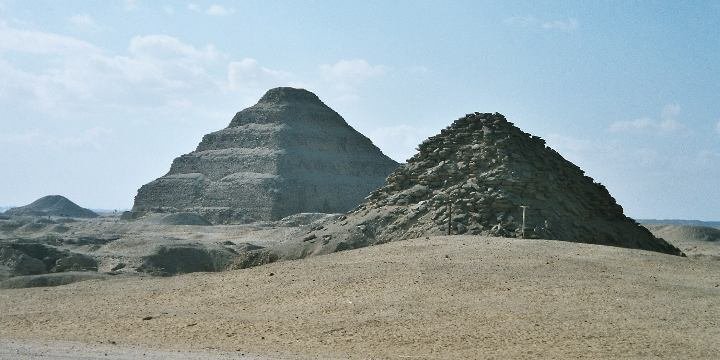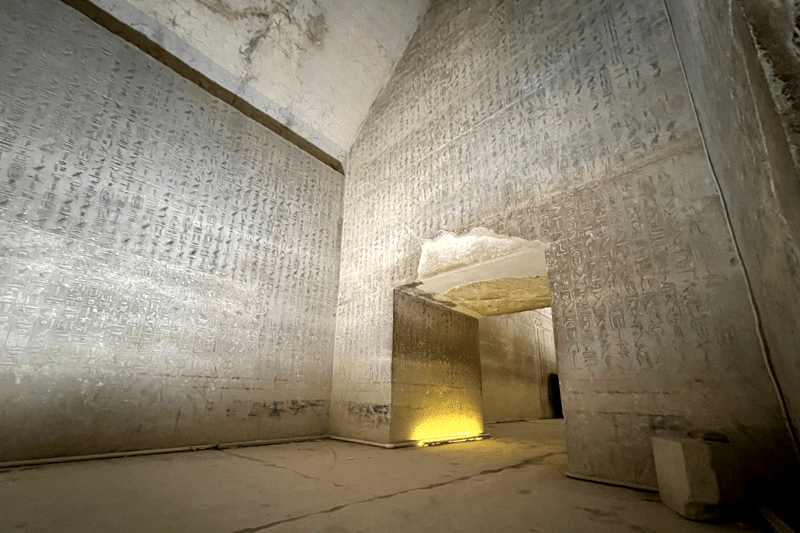
Pyramid of Unas 3D Scanning Project - WORLD SCAN PROJECT’s Challenge
In ancient Egypt's first capital, Memphis, there was a vast necropolis (burial ground) called "Saqqara," where numerous tombs of royalty, nobility, and commoners existed. Among these, the Step Pyramid of Djoser, which showcased advancements in construction techniques, and the Pyramid of Unas, which preserved the oldest funerary texts of humanity, are archaeological sites of extremely high value.
This time, the World Scan Project (W.S.P) conducted a joint survey with Dr. Yukinori Kawae, an Egyptologist at Nagoya University and an Emerging Explorer of the National Geographic Society, to perform a 3D scan of Unas's Pyramid.
The Pyramids of the Kings at Saqqara
Unas was the last ruler of the Fifth Dynasty of the Old Kingdom, reigning around the 24th century BC. His reign is believed to have lasted about 30 years, and records of diplomatic activities with neighboring countries remain, but detailed historical materials about his activities have hardly been discovered. The character of Unas remains shrouded in mystery, but the most prominent structure he built is undoubtedly the pyramid located in the northern part of Saqqara.

Photo by Olaf Tausch via Wikimedia Commons (CC BY 3.0 DEED)
The Pyramid of Unas was built southwest of the Pyramid of Userkaf and the Step Pyramid of Djoser. The Pyramid of Unas is symmetrically positioned with the Pyramid of Userkaf around the Step Pyramid of Djoser, in a layout similar to that of the three Great Pyramids of Giza. It is also known that the construction process involved leveling and filling in old royal tombs, suggesting that the site was deliberately chosen to mimic the arrangement of the three Great Pyramids of Giza.

Photo by Hajor via Wikimedia Commons (CC BY-SA 3.0 DEED)
The Pyramid Complex of Unas
Around the pyramids, it is common to find pyramid complexes that include mortuary temples, royal palaces, and enclosure walls. Similarly, the Pyramid of Unas is accompanied by a valley temple and a causeway. The causeway leading to the mortuary temple is approximately 750 meters long, comparable in length to the causeway of the largest pyramid, that of Khufu, which measures about 825 meters.
The cartouche of Unas has been preserved on the stone columns of the mortuary temple. Below his name are inscribed hieroglyphs such as the "Ankh," representing life force, and the "Djed," symbolizing stability. These inscriptions depict King Unas as "the one to whom all life has been given" and "the one to whom all stability and rule have been given."

Eund of the Causeway and entrance to the temple of the Pyramid of Unas
Photo by Jon Bodsworth via Wikimedia Commons

However, the mortuary temple itself was dismantled by Amenemhat I of the Middle Kingdom, who reused the stones for the construction of his pyramid, leaving little trace of its original state. Additionally, although the Pyramid of Unas had suffered significant weathering, it was restored during the reign of Ramesses II of the 19th Dynasty by Khaemwaset, often referred to as the first archaeologist in history.

Pyramid Texts
The entrance to the Pyramid of Unas is constructed on the north side, based on the belief that the deceased king would become one with the unset star of the northern sky. The passage extending from the entrance ends at an antechamber. Inside the pyramid, vertical hieroglyphs known as the "Pyramid Texts" are preserved. These texts are the oldest funerary inscriptions known to humanity and are considered the most significant discovery within Unas's pyramid.
The Pyramid Texts are believed to be approximately 800 spells chanted by high priests during the burial ceremonies of the king. These spells describe the king's ascension to heaven and protect the king in the afterlife. The preservation of the Pyramid Texts suggests that even after the funerary rituals of King Unas ceased, the repeated recitation of these spells would continue to confer their power, reflecting the unique Egyptian view of death in the efficacy of these spells beyond the king's death.

Among the funerary texts left in the Pyramid of Unas, there is a unique section known as the "Cannibal Hymn," which states, "Their great ones are for his morning meal, their middle-sized ones for his evening meal, their little ones for his night meal." It expresses the belief that the pharaoh absorbed divine power by consuming the gods, indicating that the pharaoh was considered an equal to the gods.
The Burial Chamber of Unas
The burial chamber presents a majestic scene, with the star-filled ceiling and the stone sarcophagus of Unas. While the Pyramid Texts in the antechamber depict the king's ascension to heaven, the burial chamber contains texts that equate the king with Osiris, the god of the underworld. This likely represents the wish that the deceased king, like Osiris who was resurrected after death, would also be assimilated with Osiris and be resurrected.


There are also spells related to the "Opening of the Mouth" ceremony. This ritual was intended to revive the mummy, and it involved purifying the sarcophagus and chanting spells, followed by touching the mummy's eyes and mouth with tools like an adze. The purpose of this ceremony was to restore the mummy's senses, enabling it to speak and eat in the afterlife, which was of great significance in ancient Egyptian culture.
Additionally, a recent discovery in the burial chamber revealed a relief of King Khufu. Near the depiction of a figure on a boat hunting with a harpoon, the name "Medjedu," an alternate name for King Khufu, was found. This indicates that the depicted figure is King Khufu and that some of the stones used in the burial chamber were repurposed from Khufu's monuments.

Bringing the World, the Future, and Curiosity Closer
The Pyramid of Unas, though modest in scale compared to other pyramids, is an extraordinarily valuable heritage site, housing the oldest known funerary texts of mankind. The Pyramid Texts, which have had a significant influence on later generations, are indispensable for exploring ancient Egyptian views on life and death and their form of faith.
However, due to weathering and human destruction to repurpose the stone materials, much of the pyramid's original structure has been lost, and the materials available to learn about King Unas are dwindling. To address this, the World Scan Project is conducting 3D scanning investigations to accurately recreate the narrow, dark passage and the intricate reliefs within King Unas's pyramid.

This data will serve as crucial material for deeper research into ancient Egyptian ruins and will also greatly help people around the world to feel closer to the mysteries and allure of ancient Egypt. If you are interested, please follow the activities of the World Scan Project and support their efforts.
Please also check out this video about the Pyramid of Unas.
この記事が気に入ったらサポートをしてみませんか?
